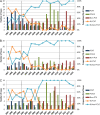Clinical and Epidemiological Evidence of the Red Queen Hypothesis in Pneumococcal Serotype Dynamics
- PMID: 27282711
- PMCID: PMC4981760
- DOI: 10.1093/cid/ciw357
Clinical and Epidemiological Evidence of the Red Queen Hypothesis in Pneumococcal Serotype Dynamics
Abstract
Background: The Red Queen hypothesis is an evolutionary theory that describes the reciprocal coevolution of competing species. We sought to study whether introduction of the 7- and 13-valent pneumococcal conjugate vaccines (PCV7 and PCV13, respectively) altered pneumococcal serotype dynamics among children with invasive pneumococcal disease (IPD) as predicted by the Red Queen hypothesis.
Methods: This study examined pneumococcal isolates (n = 641) obtained from children <18 years of age hospitalized with IPD from 1997 to 2014 in Utah. A review of the literature also identified several additional studies conducted in the United States and Europe that were used to test the external generalizability of our Utah findings. Simpson's index was used to quantify pneumococcal serotype diversity.
Results: In Utah, the introduction of PCV7 and PCV13 was associated with rapid increases in serotype diversity (P < .001). Serotypes rarely present before vaccine introduction emerged as common causes of IPD. Diversity then decreased (P < .001) as competition selected for the fittest serotypes and new evolutionary equilibriums were established. This pattern was also observed more broadly in the United States, the United Kingdom, Norway, and Spain.
Conclusions: This vaccine-driven example of human/bacterial coevolution appears to confirm the Red Queen hypothesis, which reveals a limitation of serotype-specific vaccines and offers insights that may facilitate alternative strategies for the elimination of IPD.
Keywords: children; evolution; serotype replacement; vaccination.
© The Author 2016. Published by Oxford University Press for the Infectious Diseases Society of America. All rights reserved. For permissions, e-mail journals.permissions@oup.com.
Figures


Similar articles
-
Prompt effect of replacing the 7-valent pneumococcal conjugate vaccine with the 13-valent vaccine on the epidemiology of invasive pneumococcal disease in Norway.Vaccine. 2013 Dec 16;31(52):6232-8. doi: 10.1016/j.vaccine.2013.10.032. Epub 2013 Oct 29. Vaccine. 2013. PMID: 24176490
-
Early Streptococcus pneumoniae serotype changes in Utah adults after the introduction of PCV13 in children.Vaccine. 2016 Jan 20;34(4):474-478. doi: 10.1016/j.vaccine.2015.12.010. Epub 2015 Dec 17. Vaccine. 2016. PMID: 26706276
-
Pneumococcal carriage and invasive disease in children before introduction of the 13-valent conjugate vaccine: comparison with the era before 7-valent conjugate vaccine.Pediatr Infect Dis J. 2013 Feb;32(2):e45-53. doi: 10.1097/INF.0b013e3182788fdd. Pediatr Infect Dis J. 2013. PMID: 23080290
-
Burden of invasive pneumococcal disease and serotype distribution among Streptococcus pneumoniae isolates in young children in Europe: impact of the 7-valent pneumococcal conjugate vaccine and considerations for future conjugate vaccines.Int J Infect Dis. 2010 Mar;14(3):e197-209. doi: 10.1016/j.ijid.2009.05.010. Epub 2009 Aug 22. Int J Infect Dis. 2010. PMID: 19700359 Review.
-
Experience with pneumococcal polysaccharide conjugate vaccine (conjugated to CRM197 carrier protein) in children and adults.Clin Microbiol Infect. 2013 Oct;19 Suppl 1:1-9. doi: 10.1111/1469-0691.12320. Clin Microbiol Infect. 2013. PMID: 24083785 Review.
Cited by
-
What to Do with the New Antibiotics?Antibiotics (Basel). 2023 Mar 27;12(4):654. doi: 10.3390/antibiotics12040654. Antibiotics (Basel). 2023. PMID: 37107016 Free PMC article. Review.
-
Development of experimental GBS vaccine for mucosal immunization.PLoS One. 2018 May 4;13(5):e0196564. doi: 10.1371/journal.pone.0196564. eCollection 2018. PLoS One. 2018. PMID: 29727446 Free PMC article.
-
Evaluation of Protective Efficacy of Selected Immunodominant B-Cell Epitopes within Virulent Surface Proteins of Streptococcus pneumoniae.Infect Immun. 2018 Feb 20;86(3):e00673-17. doi: 10.1128/IAI.00673-17. Print 2018 Mar. Infect Immun. 2018. PMID: 29263108 Free PMC article.
-
Sequence characterisation and novel insights into bovine mastitis-associated Streptococcus uberis in dairy herds.Sci Rep. 2021 Feb 4;11(1):3046. doi: 10.1038/s41598-021-82357-3. Sci Rep. 2021. PMID: 33542314 Free PMC article.
-
Increased carriage of non-vaccine serotypes with low invasive disease potential four years after switching to the 10-valent pneumococcal conjugate vaccine in The Netherlands.PLoS One. 2018 Mar 30;13(3):e0194823. doi: 10.1371/journal.pone.0194823. eCollection 2018. PLoS One. 2018. PMID: 29601605 Free PMC article.
References
-
- Whitney CG, Farley MM, Hadler J et al. . Decline in invasive pneumococcal disease after the introduction of protein-polysaccharide conjugate vaccine. N Engl J Med 2003; 348:1737–46. - PubMed
-
- Singleton RJ, Hennessy TW, Bulkow LR et al. . Invasive pneumococcal disease caused by nonvaccine serotypes among Alaska Native children with high levels of 7-valent pneumococcal conjugate vaccine coverage. JAMA 2007; 297:1784–92. - PubMed
-
- Byington CL, Samore MH, Stoddard GJ et al. . Temporal trends of invasive disease due to Streptococcus pneumoniae among children in the intermountain west: emergence of nonvaccine serogroups. Clin Infect Dis 2005; 41:21–9. - PubMed
-
- Jefferies JM, Clarke SC, Webb JS, Kraaijeveld AR. Risk of Red Queen dynamics in pneumococcal vaccine strategy. Trends Microbiol 2011; 19:377–81. - PubMed
-
- Neu HC. The crisis in antibiotic resistance. Science 1992; 257:1064–73. - PubMed
MeSH terms
Substances
Grants and funding
LinkOut - more resources
Full Text Sources
Other Literature Sources
Medical

